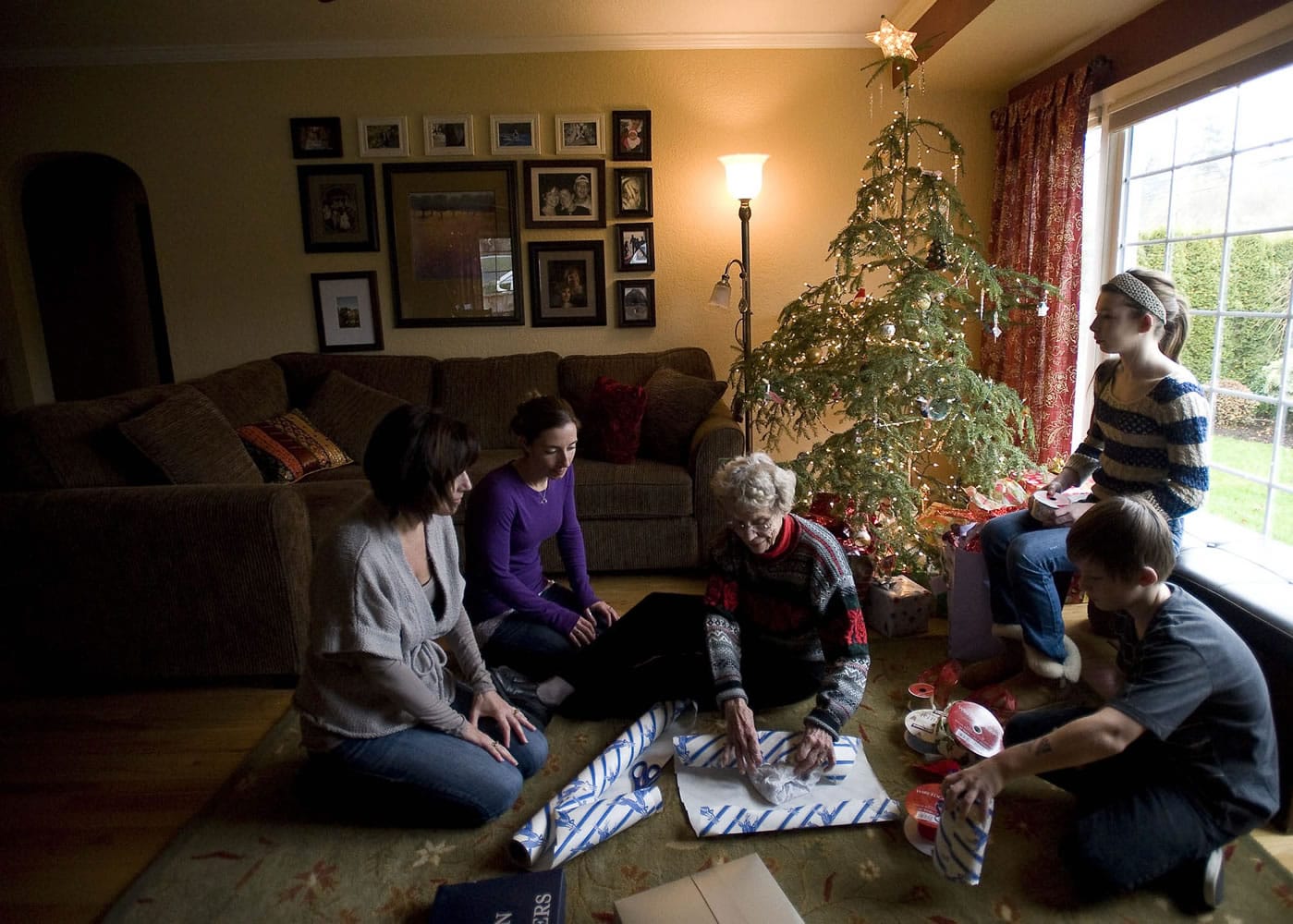It’s the gift wrap that keeps on giving.
For 56 years, Barbara Joyce Olson and members of her family have been wrapping Christmas presents with a roll of paper decorated with sleek blue reindeer.
Olson’s father brought it home with him in 1955 after his final day of work at a Vancouver paper mill.
It was gift wrap on an industrial scale — a robust roll that a guy could barely get his arms around.
“I don’t know how he got it home,” Olson, 81, said.
“For the first few years, we didn’t use much,” she said.
They started using more as the family grew. That includes Olson’s daughter, Carla Munson, who arrived a couple of years after the gift wrap.
“I’m 54 years old, and all my life, I’ve gotten Christmas presents wrapped in that paper,” Munson said.
Four generations of the family got together Wednesday in the living room of Munson’s Minnehaha-area home to keep the tradition going.
Munson’s daughter, Alaina Munson, brought her 13-year-old daughter Elle and her 11-year-old son Ashton for a gift-wrapping session in front of the Christmas tree.
War brings changes
The get-together also offered Olson a chance to recall how her folks wound up in Vancouver. It’s the story of one family, but it also reflects some significant moments in American history.
Olson was born in 1930, the only child of Bert and Beulah Stevenson. Her father owned and operated a small sawmill in northwest Wyoming.
“It was way up in the mountains,” she said, between Yellowstone National Park and Cody.
During World War II, the government took over her dad’s sawmill and brought in a new workforce: Japanese-American men who’d been interned in the Heart Mountain Relocation Center northwest of Cody. (With more than 10,000 residents, the camp temporarily was the third-largest city in Wyoming).
Bert left his wife and young daughter at their backcountry home to work at a bank in Cody.
“When dad was in Cody, mom killed a chicken. We had an enclosed front yard, and she left the entrails in a bucket by the gate,” she said.
Later in the day, Beulah and Barbara Joyce heard a sudden roar.
“A bear was trying to get over the fence,” Barbara Joyce Olson said. “Mom didn’t want to try to kill it; she didn’t have a big enough gun, for one thing.”
The bear finally gave up and shambled over to a nearby house where Barbara Joyce’s aunt lived.
When the bear announced its presence at her aunt’s house, “Her dog ran under the sawmill, and we couldn’t get him out for four days.”
Running water!
Eventually, Olson’s parents told her the whole family was moving to Cody. It was just the first in the family’s series of wartime relocations.
“I was thrilled! I’d never lived in a house with running water or electricity,” she said.
Bert Stevenson, the longtime lumberman, didn’t care much for his new bank job, however. So he headed west to look for wartime industrial work.
“He drove our 1936 Plymouth to California and stayed with my mother’s sisters. When he got a job, we went to Cheyenne to catch the train to California. My mom cooked up a big batch of fried chicken for the trip,” Olson said.
“Our train kept getting side-tracked by troop trains every 100 miles or so,” she said. “A trip that was supposed to take two or two-and-a-half days took four.”
Remember the cranky bear that had worked up an appetite for the bucket of chicken entrails? The train trip wound up kind of like that.
“People got mad because we didn’t share” the fried chicken, Olson said. “It wasn’t very pleasant.”
A place to call home
After the whole family resettled in southern California, Bert realized his wartime job at an aircraft plant didn’t suit him either.
“Friends begged him to come up here. It was more like Wyoming.”
Bert, Beulah and their daughter settled in Vancouver in1944.
Bert immediately got a job at a mill along the Vancouver waterfront that eventually became the now-demolished Boise Cascade paper mill. It brought Bert full circle, career-wise.
“To Dad’s delight, they had a sawmill connected to the paper mill, and that’s where he worked,” said Olson, who was known as Barbara Joyce Frazier while raising a family near West 28th Street in Vancouver.
Bert Stevenson retired in 1955. That day marked the end of his career, and the beginning of a family tradition.
“I have six kids, 14 grandchildren, and now I have nine great-grandchildren,” Olson said. “That is a lot of people, and a lot of years of Christmas presents wrapped in this paper.
“I think this roll still has two more Christmases to go.”
Olson said she wants her family to use up the paper, not just turn the last of the roll into a sort of museum piece.
But the end of the roll won’t mean the end of those blue Christmas reindeer, Carla Munson said.
Her mother scissored out several gift-wrap reindeer and taped them onto Christmas card keepsakes for family members.
“We’ll always have a little of it,” Munson said.




